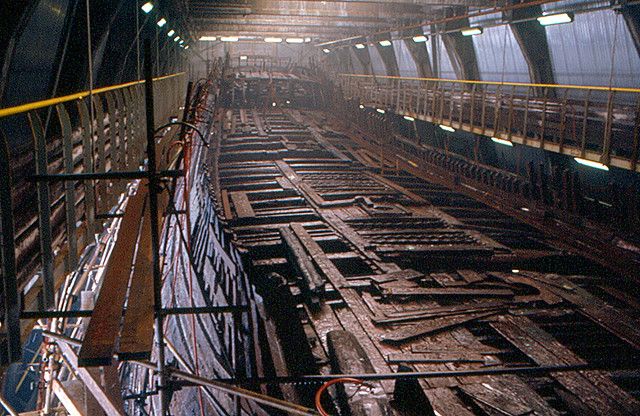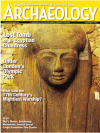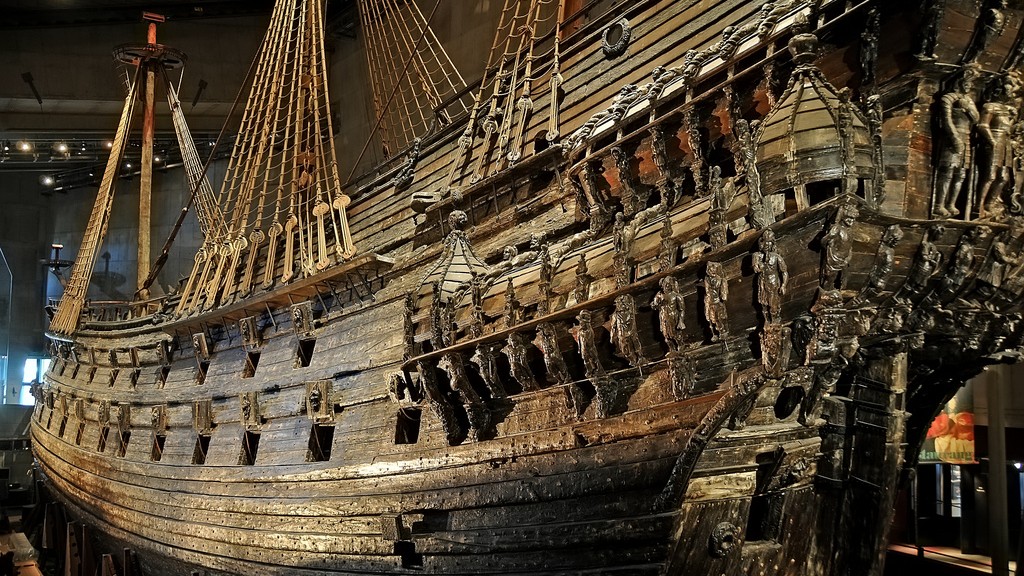The warship survived the first blast of wind it encountered on its maiden voyage in Stockholm Harbor. But the second gust did it in. The sinking of Vasa, on August 10, 1628, took place nowhere near an enemy. In fact, it sank in full view of a horrified public, assembled to see off their navy’s—and Europe’s—most ambitious warship to date. The 220-foot, triple-deck, 64-gun leviathan, elaborately adorned, had been rush-ordered for King Gustav Adolf’s war against Poland. But before it faced an opposing ship or fired a single shot, Vasa slipped beneath the waves.
Gustav angrily demanded an inquest into why his expensive new flagship lay at the bottom of the harbor. At the time, investigators found several clues. Compared with previous ships, Vasa had a thicker deck and held more and larger guns on its upper deck, making it top-heavy. When it embarked, Vasa carried almost none of the cargo and ballast that keep ships low in the water and help them resist listing. And when Vasa did list, open gun bays allowed the sea to rush in. The inquest blamed the ship’s proportions for the sinking, but without modern blueprints or measuring techniques, investiga- tors offered few details. Still, Swedish shipbuilders appeared to have learned from the experience: Vasa’s subsequent sister ships sailed without problems.
The cold, oxygen-poor water of the Baltic Sea protected Vasa from the bacteria and worms that usually digest wooden wrecks. Perhaps 95 percent of Vasa’s wood was intact when Sweden finally raised the wreck in 1961. The ship’s waterlogged wood could not support its own weight, so experts crafted a steel cradle to hold the ship, first in a temporary structure and then in a custom-built museum. Despite the cradle, Vasa began a slow-motion collapse, and preservationists scrambled to improve the cradle. They also strengthened Vasa’s wood by spraying it with polyethylene glycol continuously for 17 years, followed by nine years of drying. These challenges meant that, for decades, preservation took precedence over archaeological investigations into why the ship sank so suddenly. “Archaeologists had their hands on the ship only in the initial excavation phase: two months, for a 1,200-ton ship,” says Kroum Batchvarov, a marine archaeologist from the University of Connecticut Avery Point, and a former student of Fred Hocker, who has led the Vasa Museum’s study of the ship since 2003.

During the initial excavation in the 1960s, Vasa Museum curator Eva Marie Stolt found clues that the ship had an asymmetric structure that contributed to its instability. But archaeological recording methods are more suited to right angles than to Vasa’s curves, and the museum only budgeted time to record one side of the ship, despite her suspicions. “She was perfectly aware that she was not getting the right sort of information. It’s clear from her notes,” Batchvarov says. Among the 45,000 artifacts removed from the ship was another suggestion of an uneven construction process: Both Swedish and Dutch carpenter’s rulers, which employed different feet, were found aboard. Perhaps cultural barriers between the men under the direction of master builder Henrik Hybertsson (a Dutch-born Swede) were responsible for Vasa’s potentially crippling imbalance. Hocker’s new research at the museum, built around precise measurement and the interaction of different shipbuilding methodologies, might finally address Gustav’s demand for answers.
Today Vasa rests in an updated cradle in a vast space in the temperature- and humidity- controlled museum in Djurgården, a leafy island in central Stockholm. The ship’s dark brown timbers and intricate carvings glisten in low light as tourists move around it. “Everybody wants to know why the ship sank,” Hocker says, “but to me that’s not the most interesting question. Instead, I’d ask, ‘How did the human process of building the ship fail?’”
Hocker recruited colleagues, including Batchvarov and a survey team from East Carolina University in Greenville, North Carolina, to create a detailed digital model of the ship using laser-surveying methods. They hope to use it to untangle the choices made by the ship’s builders and apply modern mathematical analysis to calculate Vasa’s structural behavior and handling characteristics.
During four visits, the archaeological team used tripod-mounted survey devices to measure the distance from the devices to points along the edges and corners of the ship’s timbers. Hocker then integrated their data points—80,000 in all—into his digital model, and connected the points so that each beam had a digital counterpart. That resulting wireframe model reveals not just the shape of the ship, but how each of its individual components fits together.
With this first detailed digital model of the ship, which was completed earlier this year, Hocker and others are confirming some theories about Vasa’s construction and debunking others. “We’re finding virtually no evidence of change during construction,” Batchvarov says, for example, contradicting old theories that the king had meddled with the design. What the team is finding are clues that at least two kinds of construction coexisted on Vasa.
At the time of Vasa’s construction, several shipbuilding philosophies existed in Europe. The Dutch, for example, worked from the bottom up, without detailed formal plans. Their method allowed shipbuilders to work quickly, plunking in timbers wherever they fit, saving both lumber and the time it took for carpenters to hew timbers with precision. English and Mediterranean shipbuilders, on the other hand, built much more tidy, symmetrical structures based around frames with well-defined mathematical relationships.
The model showed that Vasa’s lower framing and beams were constructed in the Dutch style, reflecting the builder Hybertsson’s Dutch origin. But Hocker and Kelby Rose, a graduate student at Texas A&M University, were surprised to discover precise mathematical relationships between the keel and timbers in the upper hull, Hocker says, a characteristic archaeologists associate with Mediterranean shipbuilders. Perhaps Hybertsson grafted Mediterranean or English techniques onto a Dutch foundation and in his ambition lost a sense of the resulting center of gravity. Or the imbalance could have a more mundane cause: Hocker is analyzing the model to see if the beams on one side of the ship are consistently longer or wider than those on the other, perhaps because different construction gangs were working on different sides. “It may be that one side of the ship is much heavier than the other side, which would have created challenges in ballasting the ship, and predisposed it to being more stable heeling to one side than the other,” says Hocker.
“There’s a lot to be learned from a detailed analysis of how all the pieces of wood that constitute Vasa have been put together and how two cultures of shipbuilding interacted with each other,” says marine archaeologist Thijs J. Maarleveld of Southern Denmark University in Esbjerg, who is not involved in the Vasa study.
With such information, together with estimates of the density of each timber, engineers at the nearby Royal Institute of Technology in Stockholm should be able to calculate the ship’s center of gravity and how its weight is distributed. The former will help to quantify the degree of Vasa’s imbalance before the ship put to sea, and determine if the captain could have corrected for the asymmetry, using ballast, intuition, and experience. The latter will help the museum design a new cradle for the ship’s uneven shape. The more precise the cradle can be made, the longer Vasa will endure intact. “We started the documentation for archaeological reasons and then realized that this was exactly the same data we were going to need for preservation,” Hocker says.
Maintaining Vasa’s remarkable and rare state of preservation will allow Hocker and others to learn things about northern European shipbuilding that are impossible to ascertain from other, less complete, wrecks. And all the lessons from the preservation and digital modeling of Vasa will be useful on other wrecks, which raise similar questions about construction techniques and preservation. “Understanding the process is interesting because it gives us a better insight into the overall technology, on the solutions that were arrived at, and provides material for comparison to other wrecks,” Maarleveld says.
Armed with a detailed understanding of not just Vasa’s final shape, but how it blended shipbuilding philosophies, how the building process evolved, and what its critical flaws were, Hocker and colleagues might be able to answer both the engineering question of whether Vasa could have been made seaworthy and, more importantly, the human question of why it was not.
 First published by Archaeology Magazine, July/August 2012 [html].
First published by Archaeology Magazine, July/August 2012 [html].
Banner photo: Dennis Jarvis.
